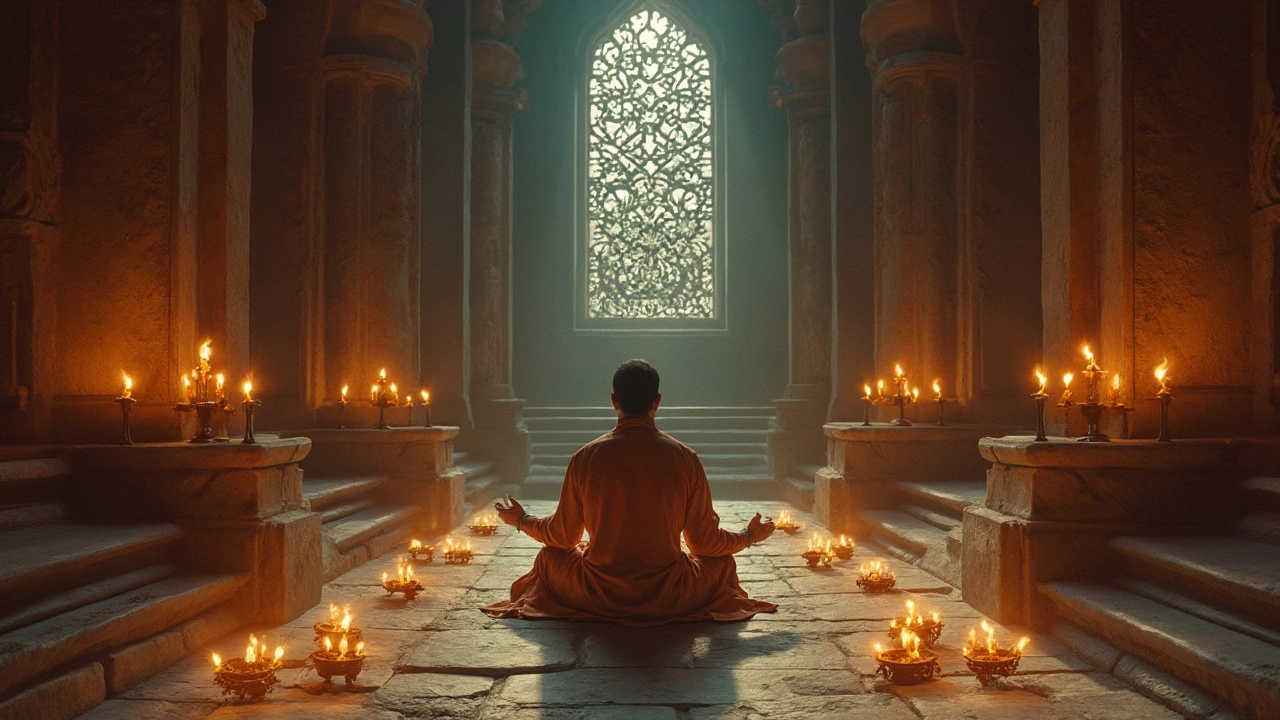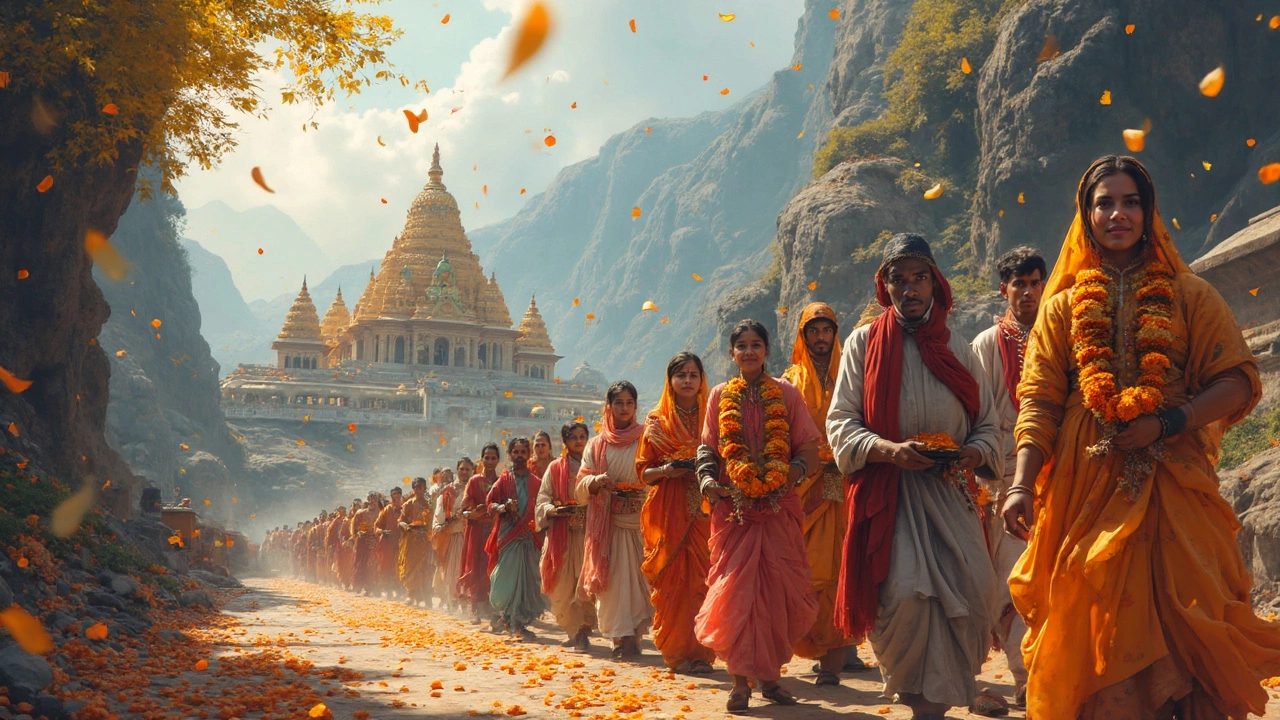Ever thought about how India's richest folks blend their wealth with age-old spiritual traditions? Believe it or not, temple visits are a common practice among Indian billionaires. And no, it’s not just about seeking blessings for more prosperity. For instance, Mukesh Ambani, one of India’s richest, is often spotted at famous temples across the country.
Why do these wealthy individuals make time for temple tours? It’s not just a show or a part of the social fabric. Many feel a deep connection to spirituality and see temple visits as a way to ground themselves. Temples like Tirupati, Shirdi, and the Golden Temple aren’t just spiritual centers; they’re also significant cultural spots that attract millions, including the rich and famous.
If you’re thinking of doing a temple tour yourself, it's worth taking a page from these billionaires' books. Plan your tour in advance, keep an open mind, and maybe even learn about the cultural stories tied to each temple. Who knows? You might just find your visit both calming and enlightening.
- Wealthiest Individuals and Their Spiritual Side
- Popular Temples Visited by Rich Indians
- Blending Luxury and Tradition
- Cultural Significance of Temple Visits
- Tips for Planning Your Own Temple Tour
Wealthiest Individuals and Their Spiritual Side
Mukesh Ambani, a familiar name when talking about the richest person in India, showcases an interesting blend of wealth and devotion. Despite leading a multi-billion dollar empire, this business magnate visits temples frequently. Seen at iconic spots like Tirupati Balaji and the Shrinathji Temple, Ambani's dedication to spiritual pursuits is evident. It’s like a ritual, grounding him amidst business pressure.
But he's not alone in this. Azim Premji, another prominent figure in India’s wealth landscape, actively engages in religious and philanthropic activities. Known for his modest lifestyle despite being a billionaire, Premji often emphasizes the importance of humility and giving back to the community.
Spiritual Rituals of Indian Tycoons
These Indian billionaires often use spirituality as a way to stay connected to their roots. It’s a key part of their lifestyle. Ambani, for example, is known to perform elaborate rituals during certain ceremonies. During the launch of certain Reliance projects, it's no surprise to see ceremonies incorporating Indian spiritual practices.
An interesting observation is that these temples, despite the influx of wealthy visitors, remain accessible to commoners. This integration offers a unique perspective on how wealth doesn’t always mean distancing oneself from cultural traditions.
A Look at the Numbers
To give you a clearer picture, here's a table reflecting visits by these billionaires to major temples over recent years:
| Billionaire | Temple | Visits (Last 5 Years) |
|---|---|---|
| Mukesh Ambani | Tirupati Balaji | 8 |
| Azim Premji | Golden Temple | 5 |
This cultural practice among the wealthy is more than a simple ritual. It's about finding balance in a fast-paced world, staying connected to one’s roots, and aligning luxury with tradition. By visiting these temples, these billionaires show us that wealth and spirituality can coexist harmoniously.
Popular Temples Visited by Rich Indians
When it comes to mixing wealth and spirituality, you'll find that India’s richest often turn to some iconic temples that hold both religious and cultural significance. Visiting these temples isn't just about personal faith for these billionaires; it’s also a way of connecting with cultural heritage, seeking blessings, and sometimes even fulfilling family traditions.
Tirupati Balaji Temple
Tirupati, located in Andhra Pradesh, is a favorite for many wealthy Indians, including top industrialists and Bollywood stars. Known for attracting donations that amount to millions, this temple is renowned for its divine prasadam (a religious offering). Many believe that a visit here is vital for success and prosperity.
Shirdi Sai Baba
Shirdi, the home of Sai Baba, isn’t just a religious place but a social leveller where everyone from the common man to the richest person in India comes to find peace. Business magnates often visit this temple to seek strength and wisdom in their endeavors.
Golden Temple, Amritsar
The Golden Temple isn’t just a place of worship; it’s a symbol of community service and equality. It's not uncommon to see wealthy individuals engaging in 'seva,' or voluntary service, in the world's largest free kitchen here. It’s an experience that humbles even the richest.
These temples often receive generous donations from Indian billionaires ranging from substantial monetary gifts to gold and silver offerings. The spiritual journeys of these affluent individuals demonstrate that no matter how high you climb in the ladder of success, returning to one’s roots and seeking divine guidance remains a cherished practice.
If you're planning a visit to any of these temples, it's a good idea to know about the traditions, dress codes, and best times to visit to avoid the rush. Plus, always keep a mindset open to the rich cultural tapestry you'll find at every corner.

Blending Luxury and Tradition
It's fascinating how India's wealthiest seamlessly merge the world of opulence with intricate traditions. While the glitz and glamour of luxurious living might seem worlds apart from the solemnity of a temple tour, they come together beautifully in India.
Take for example, the richest person in India, Mukesh Ambani. His visits to temples are often a blend of devotion and with style. For such trips, he’s known to sometimes travel by chartered flight, ensuring comfort without neglecting his spiritual commitments. Well, why not travel in comfort if you can?
But, it’s not just about how they travel. It’s also about tradition, like donating generously to the temples they visit. Donations aren't merely about flaunting wealth; they're deeply rooted in cultural practices where giving is as important as receiving blessings. In fact, many temples witness an influx of significant contributions from these visits, supporting their functioning and charitable activities.
Luxury Meets Legacy
When these industrialists visit places like the Shirdi Shrine or the Tirupati Temple, they often partake in rituals handed down through generations. It’s not uncommon for them to sponsor temple events, blend into the rituals, or simply take time out for meditation within the temple premises.
Interestingly, this fusion of wealth and tradition is seen as inspiring by many. It shows that no matter how successful one becomes, there’s always a space for tradition and spirituality in life. And maybe, just maybe, that's part of what keeps them grounded and prosperous.
So, if you’re looking to draw inspiration from these billionaire temple tours, remember it’s all about balance. Blend your modern-day comforts with the charm of ancient traditions and watch how they beautifully coexist.
Cultural Significance of Temple Visits
Temple visits aren’t just about sparing a few coins or bowing your head; they’re deeply woven into the Indian fabric of life, and that includes the lives of the richest person in India. For many, these visits provide a way to acknowledge their roots and maintain a spiritual balance in the midst of their bustling lives.
There's something truly captivating about the way temples in India operate. Whether it's the daily rituals or the massive festivities, each temple offers a peek into regional traditions and beliefs. These aren’t just religious hubs—they are living landmarks that echo India’s rich heritage and history.
The prominent Indian billionaires visiting temples highlight how spirituality transcends material wealth. Many temples have ancient tales associated with them that add layers to their cultural relevance. Take the Tirupati Temple, for example. It's not just a place; it's a part of millions' lives who visit it at least once a lifetime, including the elite.
The Connection Between Wealth and Spirituality
For centuries, temples have been a place where people, regardless of their social status, come together. This unity in diversity is a big draw for those who’ve made it big. It's their way of staying grounded and remembering where they came from. Regardless of their wealth, the ambiance of temples often acts as a reminder of the larger spiritual world beyond material success.
Stats that Tell a Story
In recent years, there’s been a noticeable increase in charitable donations by wealthy individuals to temples. Here’s a quick peek:
| Temple | Annual Donations (INR) |
|---|---|
| Tirupati Temple | 300 crores |
| Shirdi Sai Baba Temple | 150 crores |
| Golden Temple | 200 crores |
These numbers aren’t just figures; they are evidence of a continuous tradition where wealth and spirituality intersect, fueling cultural preservation and temple maintenance.

Tips for Planning Your Own Temple Tour
Planning a temple tour in India can be an enriching experience, whether you're seeking spiritual enlightenment or just exploring cultural heritage. Here are some handy tips to ensure your visit is smooth and memorable.
Research and Choose Your Temples
Start by researching the temples you want to visit. With so many iconic spots like Tirupati and Varanasi, it depends on what you’re seeking. Are you interested in Hindu temples, or would Muslim shrines like Ajmer Sharif fascinate you? Consider reading about the history and significance of each spot to make informed choices.
Travel Itinerary
Once you've decided on the temples, plan your itinerary. India is a vast country, and travel can take longer than you'd expect. Prioritizing your list will help you visit the most important places without feeling rushed. Check the distance between temples; they can be farther apart than they appear.
Respect the Customs
Understanding the local customs is crucial. Temples have specific rules about attire and behavior. For example, wearing modest clothing and removing shoes before entering are standard practices. Awareness of these customs will show respect and make your visit more enjoyable.
Timing Your Visit
Consider the best time to visit. Mornings are usually less crowded, giving you a peaceful experience. Some temples also conduct special ceremonies at certain times, which you shouldn't miss.
Pack Wisely
- Comfortable, modest clothes
- Reusable water bottle
- Snacks (in case there’s a long queue)
- Camera, if allowed for photography
A little preparation goes a long way!
Engage with the Locals
Don’t shy away from talking to the locals. They can offer insights you won't find in any guidebook, from the best timings to lesser-known must-sees in the area.
| Temple Name | Location | Best Time to Visit |
|---|---|---|
| Tirupati | Andhra Pradesh | April to September |
| Golden Temple | Amritsar, Punjab | November to March |
| Ajmer Sharif | Ajmer, Rajasthan | October to March |
With these tips, your temple tour will be both enlightening and practical, just like the richest person in India on one of their tours. Remember, it's about the journey and the discoveries you make along the way.
